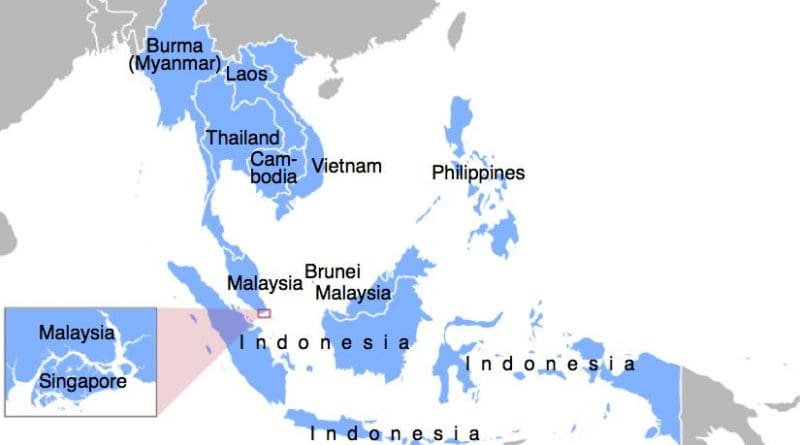Fifty Years Of ASEAN: Between Assertion And Reinvention – Analysis
By IPCS
By Angshuman Choudhury*
The Association of South East Asian Nations (ASEAN) hosted a series of annual multilateral forums between its member states and with other regional partners in Manila, Philippines, from 3-8 August 2017. These included the ASEAN Foreign Ministers’ Meeting (AMM), ASEAN Plus Three (APT) Summit, ASEAN Regional Forum (ARF), and the East Asia Summit (EAS) Foreign Ministers’ Meeting. The forums come at a historic time, with the regional organisation celebrating fifty years of existence.
The 46-page joint communiqué published on 5 August reflects two new trends within ASEAN’s post-2015 agenda: thematic expansion and structural consolidation. Both are significant in the geopolitical landscape of faltering regional alliances and emergent non-traditional, transnational threats.
These two trends suggest that the organisation is looking to broaden its role from a purely security community to one that facilitates people-centered development, and thus project itself as a ‘model of regionalism’. However, geopolitical realities and structural exigencies restrain ASEAN from realising its ambitious agenda.
Thematic Expansion
Post-2015, ASEAN has actively pushed the idea of ‘ASEAN community building’ forward under the following pillars: ASEAN Political Security Community (APSC), ASEAN Economic Community (AEC), and ASEAN Socio-Cultural Community (ASCC). Within these, five main thrust areas can be identified: regional peace and stability, connectivity, economic integration (including a free-trade regime), maritime security and cooperation, and people-centered development.
In addition, critical issue areas within the non-traditional domain like human rights, environmental protection, transnational crimes, counterterrorism, and rights of refugees and migrant workers have now begun featuring prominently in the core ASEAN agenda after years of passive observance. The organisation has also acknowledged the importance of harmonising regional goals with that of the UN’s 2030 Sustainable Development Goals (SDGs).
Structural Consolidation
In terms of structural consolidation, ASEAN’s attempt has been to deepen its position from within and without, through the dual norm of ‘one ASEAN identity’ and ‘ASEAN centrality’.
While ‘centrality’ denotes the organisation’s pivotal role in setting the Southeast Asian agenda, ‘one identity’ is a top-down design for regional consolidation. These are aimed at establishing regionalism as a durable solution to uncertainty and creating a fresh political imagination of a single Southeast Asian community that could perhaps share similar experiences in the future.
ASEAN has also begun to proactively assert itself as the leading multilateral forum in all of Asia Pacific. With its multiple extra-regional mechanisms, it hopes to engage with a broad set of actors who are key to the geopolitical and economic stability of Southeast Asia. This has put the organisation in a unique position to set the rules of the game for multilateral regionalism in the years to come.
How Feasible is the ASEAN Agenda?
The jury remains out on both ‘centrality’ and ‘one identity’. It may not ever be possible for ASEAN to create (and sustain) a single identity given the stark diversity in not just political and economic systems but also degree and quality of development among member states. The bigger question, however, is: does ASEAN even need a uniform ‘identity’ in order to succeed as a regional organisation?
At the same time, ASEAN’s core autonomy in the region – or ‘centrality’ – remains dubious. This year’s deliberations reflect this. On the one hand, ASEAN held its ground against relentless pressure from the US-Japan-South Korea axis by refusing to completely isolate North Korea over the latter’s expanding nuclear programme. On the other, however, it appears to have capitulated to Beijing’s agenda of preserving Chinese military dominance in the South China Sea (SCS) by delaying consensus on a legally-binding Code of Conduct (COC) for contested waters. This might have been an outcome of certain member states going soft on Beijing in return for greater Chinese investments in the region.
Thus, while ASEAN’s attempt to synchronise its intra-regional agenda with a broader extra-regional network (EAS, ARF, etc) is a pragmatic strategy in the face of shifting alliances, it is also a caveat in the organisation’s push towards geopolitical autonomy. This is because giving platform to bigger strategic actors could render its own agenda vulnerable to overreaching external interests.
ASEAN faces certain structural challenges in realising its agenda of people-centric development. The principle of non-interference in a member state’s ‘internal matters’ often comes in the way of community-oriented, rights-based intervention. The organisation’s incapacity in dealing with the Rohingya crisis in Myanmar and the treatment of gender minorities in Indonesia are cases-in-point.
In addition, the ASEAN Intergovernmental Commission of Human Rights’ (AICHR) limited mandate has permitted certain members to suspend their citizens’ fundamental rights with impunity. The refusal of some states to grant full-spectrum rights to migrant workers has also held the organisation back from finalising a long-pending, legally-binding instrument for the protection of their rights.
Looking Ahead
ASEAN needs to link top-down and bottom-up development. Member states must ensure that the benefits of regional economic integration, particularly a free-trade regime, percolate down to the community-level. This must be done through a model of decentralised and participatory governance, which is agnostic to individual political setups. At the same time, microeconomic agendas – like poverty alleviation and job creation – must be accompanied by a pursuit of social justice and equitable distribution.
Member states must also ensure that national security achieved through regional consolidation translates into individual security. Affirmative attention must be paid to vulnerable communities that are often left out of state-centric discourses on protection. Most importantly, ASEAN needs to recognise its own pluralism, rather than totalising the regional demography through political constructs.
* Angshuman Choudhury
Researcher and Coordinator, SEARP, IPCS
Email: [email protected]

